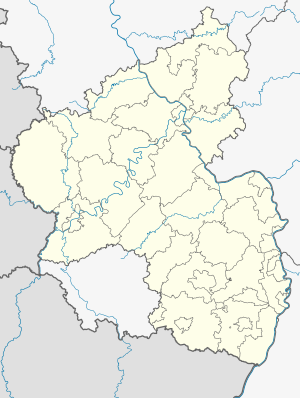BASF-Ludwigshafen power plant
| BASF-Ludwigshafen power plants | |||
|---|---|---|---|
| BASF-Ludwigshafen power plant (center right) | |||
| location | |||
|
|
|||
| Coordinates | 49 ° 30 '49 " N , 8 ° 25' 54" E | ||
| country |
|
||
| Waters | Rhine | ||
| Data | |||
| Type | Combined gas and steam power plant | ||
| Primary energy | Fossil energy | ||
| fuel | natural gas | ||
| power | 1,019 MW electrical gross 1,240 MW thermal |
||
| owner | BASF | ||
| Start of operations | 1964/1997/2005 | ||
There are three industrial power plants at the BASF site in Ludwigshafen . In addition, a nuclear power plant was temporarily planned at this location, but the construction was rejected.
Overview of power plants
| block | fuel | Gross output | Heat output | Installation |
|---|---|---|---|---|
| North | natural gas | 56 MW | 280 MW | 1964 |
| south | natural gas | 396 MW | 420 MW | 1997 |
| center | natural gas | 496 MW | 540 MW | 2005 |
BASF-Ludwigshafen North power plant
The BASF-Ludwigshafen Nord power plant has a gross electrical output of 56 megawatts and heat extraction of 280 megawatts. The power plant, which went into operation in 1964, was upgraded as a gas and steam combined cycle power plant in 2005 .
BASF-Ludwigshafen Süd power plant
The BASF-Ludwigshafen Süd power plant has a gross electrical output of 396 megawatts and a heat extraction of 420 megawatts. It is a gas-fired combined cycle power plant and was put into operation in 1997. Operational management is carried out by RWE.
The cogeneration plant consists of two gas turbines with annular combustion chambers of the type ABB 13 E2 with 162 MW each and a back pressure steam turbine with 72 MW. A maximum of 540 t / h process steam can be provided for the 6 bar rail at 180–190 ° C, i. H. 408 MJ / s. A 19 bar rail (approx. 300 ° C) can also be fed with up to 200 t / h via extraction points on the steam turbine. The gas turbines can also be fired with EL heating oil as an alternative. The fuel efficiency is 87%.
BASF-Ludwigshafen Mitte power plant
The power plant BASF-Ludwigshafen Mitte with a gross electrical output of 496 MW and a heat extraction of 540 megawatts. officially went into operation on June 30, 2005. The heat extraction corresponds to an hourly steam generation of 650 t for the on-site consumers. Like the other two power plants at the BASF-Ludwigshafen site, it is a combined cycle power plant: It consists of two gas turbines (manufacturer: Siemens , annular combustion chamber type) with an electrical output of 180 MW each . The waste heat is generated by means of an open, i.e. H. not in the enclosed, two-pressure boiler (one per gas turbine, LP and HP, manufacturer: MCE AG ) process steam. The process steam is made available to the on -site steam network in three different pressure levels via a back pressure steam turbine (manufacturer: Siemens) with an output of 80 MW. Alternatively, if the steam turbine is not ready, the steam can be reduced using reducing stations. The electricity is fed into the Amprion network via 220 kV lines. As a result, BASF now generates 65% instead of 15% of its electricity needs in its own plants at the Ludwigshafen site.
The construction of the 240 million euros power plant (adjusted for inflation to around 290 million euros in 2020) was BASF's largest investment at this location since the 1970s. The energy efficiency of the system is more than 90%. In the event of a failure of one of the two gas turbines, a gas-fired additional furnace in the other boiler compensates for the lack of process steam within a few minutes in order to keep the on-site steam networks at a stable pressure. The power plant is cooled by river cooling. The internal systems are often redundant (e.g. secondary cooling water circuits that are independent of one another for each of the three turbo sets ) so that high availability can be achieved.
The location of the power plant is almost exactly opposite the confluence of the Neckar into the Rhine in Ludwigshafen.
Until 2001 there was a 200 meter high chimney.
Nuclear power plant (discarded)
Instead of a gas turbine power plant, the power plant was originally to be built as a nuclear power plant with a pressurized water reactor . In contrast to other nuclear power plants, the power plant would not have served to generate public electricity, but to generate process steam and to cover the electricity needs of the BASF Group.
Data of the reactor block
| Reactor block | Reactor type | Net power | Gross output | Beginning of project planning | start of building | Project setting |
|---|---|---|---|---|---|---|
| BASF-1 | Pressurized water reactor | 385 MW | 425 MW | - | - | 1st December 1976 |
Individual evidence
- ↑ a b c d e power plants in Germany (from 100 megawatts of electrical output). (Excel file, 122 KiB) (No longer available online.) Federal Environment Agency , August 15, 2012, archived from the original on October 15, 2012 ; Retrieved November 19, 2012 .
- ↑ a b CCGT plant in Ludwigshafen. (PDF file, 876 KiB) RWE Energie AG , May 6, 2003, accessed on September 10, 2015 .
- ↑ Reinforced concrete chimneys . MB SPEZIALABBRUCH GMBH & CO.KG. Retrieved June 24, 2019.
- ^ Ludwigshafen BASF Power Plant Chimney . skyscraperpage.com. Retrieved June 24, 2019.
- ↑ The BASF-1 nuclear power plant in the IAEA's PRIS ( Memento from June 4, 2011 in the Internet Archive )

